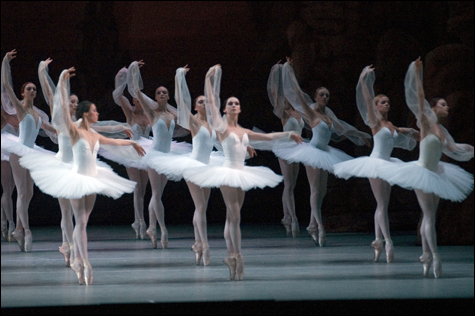
DOWNSIZING: At City Center, the Kirov dancers had to replot their working space. |
NEW YORK — On a midweek visit to the global city, just about any time of year, you can sample a stupefying range of dance performances, not to mention dance films, dance history, and dance-related installation art. I missed more things in two and a half days last week than I managed to take in, so whatever I might infer about dance in the New York vortex could have come out a different way if I’d reversed my priorities.
One thing that’s obvious everywhere, however, is the obsession with highly charged and technically refined physicality. The audience, theoretically addicted to nostalgic revivals of 19th-century story ballets, would just as soon see them in sleek, virtuosic reductions focused exclusively on dancing. This was the assumption of the Kirov Ballet’s first program in a three-week run at New York City Center.
The Russians have never played a medium-size theater in New York with the full company — the Metropolitan Opera House is their usual venue — and they had to downsize for City Center. There were painted backdrops instead of sets, and a slight uneasiness as the dancers replotted their working space.
But the three all-dance excerpts from the Petipa repertory of the Imperial Mariinsky period were part of a larger strategy to showcase a 150-year stylistic history. Subsequent programs (through 20 April) were to include more Petipa excerpts; a set of early 20th-century one-acts by the reformer Michel Fokine, who decamped with Diaghilev’s Ballets Russes, an independent enterprise based in France that never played the Soviet Union; three ballets by George Balanchine, who wasn’t able to bring New York City Ballet to his native country until the Cold War eased up in the 1960s; and an evening of dances by the German-based expatriate American William Forsythe. Talking about this momentous visit on the basis of a single performance can be little more than a series of impressions.
The third act of Raymonda is a wedding celebration, the happy ending to a plot whose complications allow balleticized folk dances to be woven into a classical framework. Aleksandr Glazunov’s mazurkas and csárdás are supposed to create a dramatic contrast with the classical pas de deux and coda, but the dancers didn’t look grounded, even when they were stamping and whirling. An alternative to the prevailing mood of decorum was Nadezhda Gonchar, in the Variation, who did just about the only allegro dancing of the evening.
Ballerina Olesia Novikova and her partner Andrian Fadeev exaggerated the head tosses and off-center shapes Petipa injected into the classical style, but neither dancer looked converted. In the famous cembalon variation, when she yields to the excitement of her dance with a vigorous handclap, Novikova’s palms barely waved at each other.
There was more dance texture in the Grand Pas from Paquita, with its specialty variations. The first one featured a six-o’clock extension, essentially a split standing up, which Petipa can hardly have imagined but which dancers with sprung hip joints can achieve now. The dancer, Alina Somova, I think, did one right away, then repeated it several times, to the audience’s bravos. I missed seeing Diana Vishneva when the variation she was listed for was omitted on Wednesday night. Principal Victoria Tereshkina, partnered by Yevgeny Ivanchenko, impressed me with a big, confident persona to match her technique.